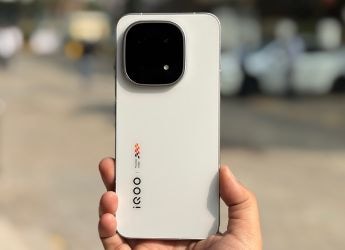- Home
- Telecom
- Telecom Features
- How India Is Leading the World's March Towards IPv6 (And What It Means)
How India Is Leading the World's March Towards IPv6 (And What It Means)

India tops the list of of 244 countries with 54 percent IPv6 connections
India has a fast growing Internet population, with the vast majority of new users coming online via their smartphones. But with the arrival of connected devices that form Internet of Things (IoT) and the conceptualisation of smart cities, the country is upgrading its existing Internet-powering infrastructure. Telecom operators are adding new base stations to cater to the growing demand. Similarly, the government is upgrading its policies and bringing new regulations to help people have effective and efficient connectivity at their doorstep. In this fast-moving environment, India has already started leaving behind legacy technologies like Internet Protocol version 4 (IPv4) and started switching to newer, more advanced like IPv6.
"IPv6 is the future," says Vaishali Sangtani, Product Marketing Manager, Web Global Industry and Product Marketing, APJ, Akamai. "All the improvements to Internet standards, protocols, and security will be focused on IPv6 that IPv4 will not benefit from. Hence, it's in our interest to not miss the boat."
The most well-known benefit that IPv6 offers is the increased number of addressable devices by giving more unique IP addresses than what can be derived through IPv4. The 32-bit IPv4 addressing format enables 4.3 billion IP addresses across the globe. Operators use measures like NAT (Network Address Translation) and CIDR (Classless Interdomain Routing) to extend the life of IPv4 addresses to some extent, though.
However, Nokia India Head of IP and Optics Business Group Satish Yadav underlines that NAT has its own limitations and given the rate of the Internet user growth, 5G, and IoT adoption in the country, NAT is simply not viable going forward.
"NAT has commercial implication also," Yadav continues. "Those who got IPv4 addresses allocated in the past and not using it, are selling it on a heavy premium of nearly $1 (roughly Rs. 70) per address. IPv6, on the other hand, has huge address space, practically un-consumable in foreseeable future, thereby allowing simple, seamless, and cost-effective connectivity for service provider and hence for end users."
The 128-bit IPv6 addressing format offers 340 sextillion IP addresses, making it extremely future-proof. But that's not all, IPv6 is also considered as a protocol of better reliability and security.
"IPv4 ICMP packets are often blocked by corporate firewalls because they could potentially carry malware," Akamai's Sangtani says. "But IPv6 promises better reliability and security as IPSec, a protocol for authenticating and securing all IP data, is built into IPv6 as a default. IPSec, which provides confidentiality, authentication, and data integrity, is backed into in IPv6."
Netgear Technical Head for India and SAARC Manab Mallick underlines that IPv6 also speeds up the communication through routers.
"IPv6, as compared to IPv4, specifies a new format for packet transfer with the network, which is designed to minimise processing by routers," Mallick states. "This would help the devices in the network to communicate faster and ensuring faster connectivity to users."
IPv6 is also supposed to make offerings such as Quality of Service (QoS) for service providers more robust. ACT Fibernet CTO Prasanna Gokhale tells Gadgets 360 that IPv6 packet head comes with a new field called Flow Label that ensures more efficient delivery of information from one end to another over what can be handled through an IPv4 network, without the possibility of it being modified by intermediate systems.
"This [IPv6] ensures a high degree of QoS especially for peer-to-peer applications like VoIP and other real-time applications," says Gokhale. "IPv6 also supports multicast rather than broadcast. Multicast allows bandwidth-intensive packet flows (like multimedia streams) to be sent to multiple destinations simultaneously, saving network bandwidth."
Spectra CTO Ravishanker N emphasises that it is imminent for service providers in India to move to IPv6 since IPv4 addresses have been almost exhausted. "The service providers need to make sure that both IPv4 and IPv6 are compatible with the ISP, which is technically called dual stack. There is a need for compatibility because not all websites will be able to resolve through IPv6," he says.
The Spectra CTO also says that IPv6 helps service providers reduce broadcast in the network and makes packet processing more efficient.
ACT Fibernet's Gokhale foresees that with IPv6, more than 64,000 devices at a home would easily be connected on Wi-Fi and would still be uniquely identifiable over the Web with a unique IP address each.
"Some of the applications emerged in recent days are peer-to-peer applications such as multi-player online games, video-conferencing (streaming video and audio), file sharing, and VoIP," Gokhale adds.
"In peer-to-peer networking, a group of computers can communicate directly with each other and do not need a central server. Peer-to-applications, therefore, demand end-to-end connections between unique IP addresses."
India leads in IPv6 adoption
According to the State of Internet IPv6 Adoption Visualisation shown by Akamai, India tops the list of of 244 countries with 54 percent IPv6 connections.
Akamai's Sangtani tells Gadgets 360 that the largest volumes of IPv6 requests are driven by cable and wireless/ mobile providers. "The significant spike observed in the adoption of IPv6 in the first quarter of 2017 can be attributed to India's major mobile network providers who started driving adoption," she states.
![]()
Visualisation showing the IPv6 adoption globally
Photo Credit: Akamai
An APNIC report, as cited by Yadav of Nokia India, reveals that only Belgium is ahead of India with 58.14 percent IPv6-enabled devices of the entire Internet-enabled device base. However, the overall device base in Belgium is just over 10 million, in comparison with India's device base of over 475 million, 52.49 percent are IPv6 devices, according to the APNIC report, giving it a much larger install base.
"In terms of absolute numbers, India has the highest IPv6 devices, nearly 250 million, which is almost double of the US on the second position with nearly 120 million such devices. This is only going to grow with the advent of 5G, adaptation of IoT, and increase in the number of smartphones," explains Yadav.
"We have been falling short even when there was just computers talking to each other as a network," says Sangtani of Akamai. "Then smartphones came along. There are about 500 million smartphones in India today and we'll soon have air conditioners, refrigerators, wearables, and billions of other 'things' as connected devices powering the ever-connected world. With India's expeditious incremental adoption of IPv6, we are addressing the need for being ready for the exponential growth powered by IoT."
Cisco Vice President for Engineering Suhas Mansingh tells Gadgets 360 that the rapid pace of IPv6 adoption paints an encouraging picture for the IPv6 market in the country.
"Thanks to Reliance Jio, India today is one of the top five players for IPv6 consumption and accounts for 20 percent of global usage," says Mansingh. "And this is going to get bigger and better with more number of organisations entering the IPv6 fold, switching from IPv4 protocol can accommodate only 4.3 billion possible IP addresses as against 340 trillion, trillion, trillion IPv6 addresses."
Reliance Jio indeed comes as a 100 percent IPv6 compliant operator in India, thanks to its digital, VoLTE network. However, COAI Director General Rajan S Mathews points out that other operators in the country are also slowly moving and adopting IPv6.
"Most of our operators are more or less IPv6 compliant in the current scenario," Mathews of COAI tells Gadgets 360.
![]()
Operator-wise IPv6 adoption in India
Photo Credit: APNIC
"The user interface, by and large, will remain be the same after moving to IPv6, though at the back end, there are benefits such as enhanced security, and it allows faster routing," says Mathews.
"The IPv6-based network performance may not make much difference to the end user, but in the backend, they may experience seamless connectivity, faster network, and more secure network," says Hemant Joshi, Partner, Deloitte India. “In the future with more and more adoption of IPv6, users may connect to multiple IoT devices without any connectivity issues."
"Apart from the massive pool of unique addresses, IPv6 will be helpful for providing efficient routing and security which is necessary for the Digital India initiative and will be helpful in different innovative applications such as online healthcare, precision agriculture, and smart city applications," he adds.
In July, Telecom Commission approved a new telecom policy called the National Digital Communication Policy 2018 (NTP 2018) that specifies India's aim for "substantial" transition to IPv6 by 2020. The government also formed an India IPv6 Task Force to push the deployment towards IPv6. Reserve Bank of India (RBI) in late 2012 also asked payment operators to move to the new protocol. Moreover, in July 2010, the country received an IPv6 roadmap that brought 10 workgroups to deploy the new protocol.
New Telecom Policy Is Here but What About the Previous One?
That being said, telecom operators consider that support for IPv6 on consumer devices is vital to make the new protocol successful in the market.
"Support for IPv6 on mobile phones, DSL modems (CPEs) et al. is important for its success," an Airtel spokesperson said in an emailed statement to Gadgets 360. "In addition to this, networks and Web content should support IPv6. Only then there will be a faster adoption of the standard."
Mallick specifies that Netgear devices take care of the coexistence of both IPv4 and IPv6 network address system using a dual-stack mechanism. "A device with dual-stack mechanism would have an IPv4 address and IPv6 address and can communicate with other devices in the network with either IPv4 or IPv6 address system," he adds.
While Reliance Jio dominates when it comes to an IPv6-compliant network, Airtel was among the first ones to offer IPv6-based networks in India. Likewise, ACT Fibernet and Spectra are the among the key broadband players in the country that support IPv6. The former even officially announced IPv6 implementation back in May.
"Within a short time of one quarter, we have seen that about 15 percent of our traffic is on IPv6 and increasing every day," reveals Gokhle of ACT Fibernet.
Just like ACT Fibernet, Spectra is claimed to be fully compliant on IPv4 and IPv6 dual stack. Spectra is, however, currently providing IPv6 to some business customers on the basis of their requirements, whereas ACT Fibernet has already started delivering IPv6 networks to end customers.
"ACT Fibernet has undergone various network and software transformations in the last few years to support IPv6 and IPv4 dual stack in its entire network and has become a pioneer in the wired broadband segment," claims ACT Fibernet's Gokhle.
Challenges in IPv6 rollout
Akamai's Sangtani points out that end-to-end IPv6 adoption needs networks/ IPS upgrading their data centres and networking infrastructure, IPv6 content, and IPv6 enabled client devices and operating systems.
"For India, like most countries, the network providers are driving IPv6 as a strategic imperative, but costs of upgrades are high on the part of both infrastructure that includes servers, routers, firewalls, billing systems, and software applications, and operational upgrades in terms of skilled resources and processes," explains Sangtani.
"However, between the cost of acquiring an IPv4 address from the residual stack versus operating a dual stack network with both IPv4 and IPv6, the balance is shifting towards making it less economical to continue running on IPv4. This should nudge the business case of faster rates of adoption. It's costly to upgrade to IPv6 but incrementally costlier to continue operating IPv4, so better invest in the future."
Yadav of Nokia India stresses that while most network nodes support IPv6 barring very old and legacy equipment, a major challenge is on the part of IPv6-based content availability and old user devices.
"Most of the old user devices still don't support dual stack, and most of the content hosted in the past is IPv4 based. Expertise and familiarisation with IPv6 for end users as well as network engineers are also speed breakers in IPv6 adoption," says Yadav.
Most major websites and content providers such as Google, Facebook, Twitter, Netflix, and WhatsApp have already enabled their services over IPv6. Newer devices, including smartphones, notebooks, and IoT hardware, are also IPv6-enabled by default. However, a large number of websites are yet to adopt the new protocol.
"The world can never shift to IPv6 completely and discard IPv4 until all the websites support IPv6," exclaims ACT's Gokhale.
Cisco's Mansingh says that the transition to a pure IPv6 facility is a mammoth task. "Organisations need to ensure that there are no disruption to critical services as a large number of Web applications were devised without IPv6 in mind and would require network plumbing — writing a translator for domains that are still running on IPv4, customer-centric practices like engaging with multiple users and being proactive to enable a wide range of devices," he says.
The executive also underscores that a majority of enterprises operating on the IPv4 protocol are still not ready to incur investments to move to the new protocol standard citing lack of direct financial gain.
"The other barrier restraining companies is perception towards IPv6 security as they feel IPv4 has gone through the lifecycle of discovery and repair of vulnerabilities giving it the robustness which lacks in the case of IPv6 as it is still a work in progress. In reality, IPv6 does address a lot of security issues," he adds.
TechARC Founder and Principal Analyst Faisal Kawoosa states that it isn't just the case of IPv6 but also the technology adoption in India in such cases where it's more of replacement than new deployment has always been a slow one.
"The main reason has been the money to put it," says Kawoosa. "Other than this is, of course, skills and infrastructure. From telco's point of view, the disruption that is eroding revenues is another impediment that restricts their ease and comfort to upgrade."
That being said, companies such as Cisco are helping businesses succeed and seamlessly move to IPv6.
Cisco particularly offers a three-pronged approach, as detailed by Mansingh, that is to help businesses preserve their investments in IPv4 infrastructure, assets, and delivery models; prepare for smooth, incremental transition with interoperable IPv4 and IPv6 services; and prosper through the transition to a global IPv6 customer base.
"Through leadership in developing standards on the Internet Engineering Task Force (IETF) and integrating IPv6 into its technology portfolio, Cisco has prepared for this significant transition," Mansingh tells Gadgets 360. "This integration has helped customers preserve their technology investments. Today, a broad range of architectures, products, and services is offered to help customers establish a plan to implement IPv6."
Nokia India's Yadav tells Gadgets 360 that the Finnish giant, which is one of the leaders in IP networking and a provider of equipment to leading telcos, is also helping operators enable IPv6 in a phased manner without any disruption to their existing services.
"This includes consultancy, high- and low-level design and adaptation of IPv6 friendly network architecture today, for future readiness," says Yadav, adding, "On product side, our all developments are happening on IPv4 and IPv6 in parallel, and more and more features are being added to facilitate smooth IPv6 adaptation."
Catch the latest from the Consumer Electronics Show on Gadgets 360, at our CES 2026 hub.
Related Stories
- Samsung Galaxy Unpacked 2025
- ChatGPT
- Redmi Note 14 Pro+
- iPhone 16
- Apple Vision Pro
- Oneplus 12
- OnePlus Nord CE 3 Lite 5G
- iPhone 13
- Xiaomi 14 Pro
- Oppo Find N3
- Tecno Spark Go (2023)
- Realme V30
- Best Phones Under 25000
- Samsung Galaxy S24 Series
- Cryptocurrency
- iQoo 12
- Samsung Galaxy S24 Ultra
- Giottus
- Samsung Galaxy Z Flip 5
- Apple 'Scary Fast'
- Housefull 5
- GoPro Hero 12 Black Review
- Invincible Season 2
- JioGlass
- HD Ready TV
- Laptop Under 50000
- Smartwatch Under 10000
- Latest Mobile Phones
- Compare Phones
- OPPO Reno 15 FS
- Red Magic 11 Air
- Honor Magic 8 RSR Porsche Design
- Honor Magic 8 Pro Air
- Infinix Note Edge
- Lava Blaze Duo 3
- Tecno Spark Go 3
- iQOO Z11 Turbo
- Lenovo Yoga Slim 7x (2025)
- Lenovo Yoga Slim 7a
- Lenovo Idea Tab Plus
- Realme Pad 3
- Moto Watch
- Garmin Quatix 8 Pro
- Haier H5E Series
- Acerpure Nitro Z Series 100-inch QLED TV
- Asus ROG Ally
- Nintendo Switch Lite
- Haier 1.6 Ton 5 Star Inverter Split AC (HSU19G-MZAID5BN-INV)
- Haier 1.6 Ton 5 Star Inverter Split AC (HSU19G-MZAIM5BN-INV)







![[Sponsored] Haier C90 OLED TV | Dolby Vision IQ, 144Hz OLED and Google TV in Action](https://www.gadgets360.com/static/mobile/images/spacer.png)









